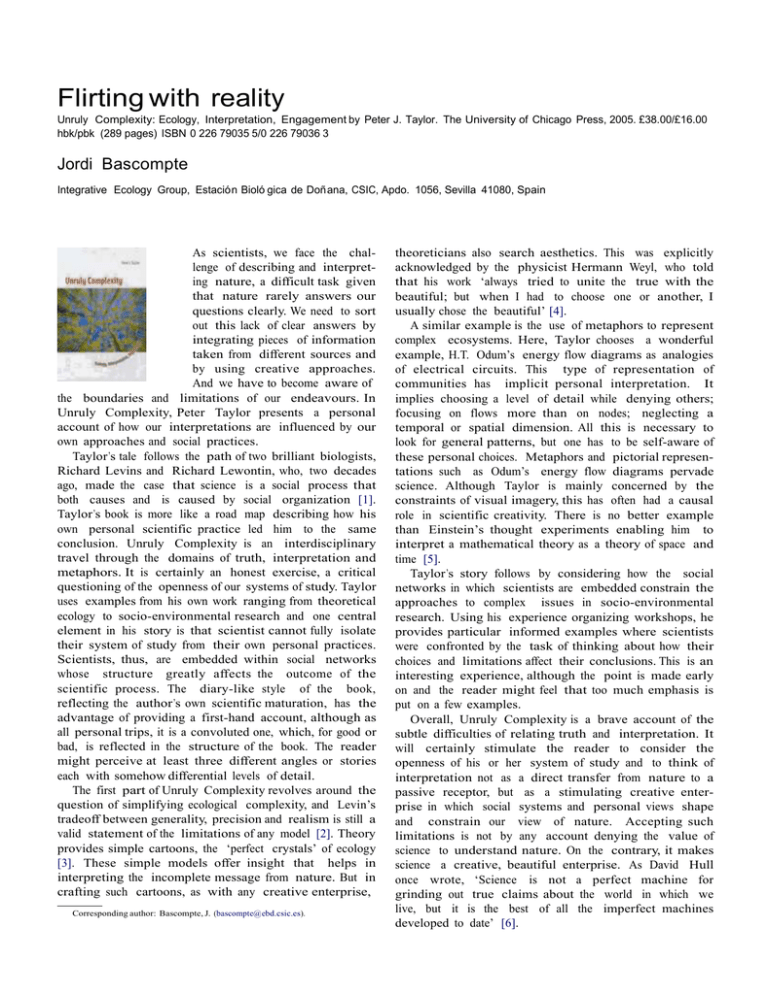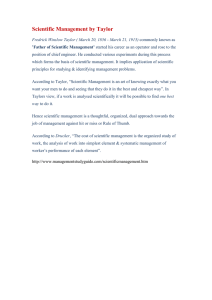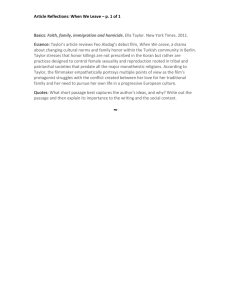TREE-06.doc
advertisement

Update Flirting with reality Unruly Complexity: Ecology, Interpretation, Engagement by Peter J. Taylor. The University of Chicago Press, 2005. £38.00/£16.00 hbk/pbk (289 pages) ISBN 0 226 79035 5/0 226 79036 3 Jordi Bascompte Integrative Ecology Group, Estació n Bioló gica de Doñ ana, CSIC, Apdo. 1056, Sevilla 41080, Spain As scientists, we face the challenge of describing and interpreting nature, a difficult task given that nature rarely answers our questions clearly. We need to sort out this lack of clear answers by integrating pieces of information taken from different sources and by using creative approaches. And we have to become aware of the boundaries and limitations of our endeavours. In Unruly Complexity, Peter Taylor presents a personal account of how our interpretations are influenced by our own approaches and social practices. Taylor’s tale follows the path of two brilliant biologists, Richard Levins and Richard Lewontin, who, two decades ago, made the case that science is a social process that both causes and is caused by social organization [1]. Taylor’s book is more like a road map describing how his own personal scientific practice led him to the same conclusion. Unruly Complexity is an interdisciplinary travel through the domains of truth, interpretation and metaphors. It is certainly an honest exercise, a critical questioning of the openness of our systems of study. Taylor uses examples from his own work ranging from theoretical ecology to socio-environmental research and one central element in his story is that scientist cannot fully isolate their system of study from their own personal practices. Scientists, thus, are embedded within social networks whose structure greatly affects the outcome of the scientific process. The diary-like style of the book, reflecting the author’s own scientific maturation, has the advantage of providing a first-hand account, although as all personal trips, it is a convoluted one, which, for good or bad, is reflected in the structure of the book. The reader might perceive at least three different angles or stories each with somehow differential levels of detail. The first part of Unruly Complexity revolves around the question of simplifying ecological complexity, and Levin’s tradeoff between generality, precision and realism is still a valid statement of the limitations of any model [2]. Theory provides simple cartoons, the ‘perfect crystals’ of ecology [3]. These simple models offer insight that helps in interpreting the incomplete message from nature. But in crafting such cartoons, as with any creative enterprise, Corresponding author: Bascompte, J. (bascompte@ebd.csic.es). theoreticians also search aesthetics. This was explicitly acknowledged by the physicist Hermann Weyl, who told that his work ‘always tried to unite the true with the beautiful; but when I had to choose one or another, I usually chose the beautiful’ [4]. A similar example is the use of metaphors to represent complex ecosystems. Here, Taylor chooses a wonderful example, H.T. Odum’s energy flow diagrams as analogies of electrical circuits. This type of representation of communities has implicit personal interpretation. It implies choosing a level of detail while denying others; focusing on flows more than on nodes; neglecting a temporal or spatial dimension. All this is necessary to look for general patterns, but one has to be self-aware of these personal choices. Metaphors and pictorial representations such as Odum’s energy flow diagrams pervade science. Although Taylor is mainly concerned by the constraints of visual imagery, this has often had a causal role in scientific creativity. There is no better example than Einstein’s thought experiments enabling him to interpret a mathematical theory as a theory of space and time [5]. Taylor’s story follows by considering how the social networks in which scientists are embedded constrain the approaches to complex issues in socio-environmental research. Using his experience organizing workshops, he provides particular informed examples where scientists were confronted by the task of thinking about how their choices and limitations affect their conclusions. This is an interesting experience, although the point is made early on and the reader might feel that too much emphasis is put on a few examples. Overall, Unruly Complexity is a brave account of the subtle difficulties of relating truth and interpretation. It will certainly stimulate the reader to consider the openness of his or her system of study and to think of interpretation not as a direct transfer from nature to a passive receptor, but as a stimulating creative enterprise in which social systems and personal views shape and constrain our view of nature. Accepting such limitations is not by any account denying the value of science to understand nature. On the contrary, it makes science a creative, beautiful enterprise. As David Hull once wrote, ‘Science is not a perfect machine for grinding out true claims about the world in which we live, but it is the best of all the imperfect machines developed to date’ [6]. References 1 Levins, R. and Lewontin, R. (1985) The Dialectical Biologist, Harvard University Press 2 Levins, R. (1966) The strategy of model building in population biology. Am. Sci. 54, 421–431 3 May, R.M. (1973) Stability and Complexity in Model Ecosystems, Princeton University Press www.sciencedirect.com 4 Chandrasekar, S. (1987) Truth and Beauty: Aesthetics and Motivations in Science, The University of Chicago Press 5 Miller, A.I. (1996) Insights of Genius: Imagery and Creativity in Science and Art, Springer-Verlag 6 Hull, D.L. (1988) Science as a Process: An Evolutionary Account of the Social and Conceptual Development of Science, The University of Chicago Press

